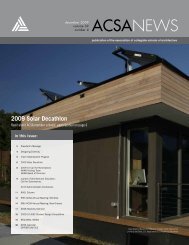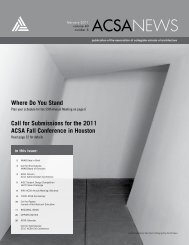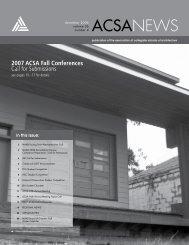digital aptitudes - Association of Collegiate Schools of Architecture
digital aptitudes - Association of Collegiate Schools of Architecture
digital aptitudes - Association of Collegiate Schools of Architecture
Create successful ePaper yourself
Turn your PDF publications into a flip-book with our unique Google optimized e-Paper software.
FRIDAY, MARCH 2, 2012 - 11:00AM - 12:30PM<br />
Open: Disaster Recovery<br />
Charles Setchell, USAID Office <strong>of</strong> US Foreign Disaster Assistance<br />
Digital and Analog Aptitudes in Emergency Shelter<br />
Design and Fabrication<br />
Bruce Johnson, University <strong>of</strong> Kansas<br />
The Article discusses the flux between the Digital and Analog<br />
realms in the design, fabrication and outcome <strong>of</strong> a Prototype Emergency<br />
Shelter as conceived in a third year “hands-on” architectural<br />
design studio. The article examines the studio design process with<br />
relationship to both the physical needs <strong>of</strong> victims and refugees<br />
and with regard to fabrication and design development within the<br />
architectural studio itself. Currently and in the recent past there<br />
has been much emphasis on Crisis <strong>Architecture</strong> as it pertains to<br />
the need for large quantities <strong>of</strong> housing for victims and refuges <strong>of</strong><br />
Hurricanes, Floods, War, Tsunamis, Earthquakes, etc. and humanmade<br />
disasters, this article illustrates the need for such housing<br />
projects to examine the cultural requirements <strong>of</strong> privacy, family<br />
function, and enclave or neighborhood development in temporary<br />
housing communities such as to facilitate a sense <strong>of</strong> ownership and<br />
personal/family pride. For both Pr<strong>of</strong>essionals and Students, Crisis<br />
architecture requires the study <strong>of</strong> not only the specific needs for<br />
family and community housing during a Crisis, but also <strong>of</strong> the ability<br />
<strong>of</strong> various government agencies, volunteers, and even victims,<br />
to be able to organize, construct, and to maintain society during<br />
conditions that <strong>of</strong>ten manifest power outages and a complete lack<br />
<strong>of</strong> communication interface. Increasingly Pr<strong>of</strong>essionals and Design<br />
students flaunt advanced Digital interfaces for the study and<br />
manufacture <strong>of</strong> buildings, components and models – the article illustrates<br />
that design is a hybrid <strong>of</strong> whatever means are available<br />
and that Crisis architecture must adapt in the field in order to best<br />
serve society in a time <strong>of</strong> need.<br />
Bruce A. Johnson is an Assistant Pr<strong>of</strong>essor at the University <strong>of</strong><br />
Kansas. He graduated with honors from Kansas State University<br />
in 1991 where he was awarded the American Institute <strong>of</strong> Architects<br />
Certificate <strong>of</strong> Merit. In 1995 he received a scholarship to attend<br />
Columbia University where he was a recipient <strong>of</strong> the Lowenfisch<br />
Memorial Prize for best thesis (The Split-Level Sod House). He has<br />
practiced in Kansas City for firms such as Populous, Shaughnessy,<br />
Fickel and Scott, PGAV, and International Architects Atelier, and<br />
in Chicago for Stanley Tigerman and Margaret McCurry. In 1991 he<br />
was awarded the prestigious Skidmore, Owings & Merrill Bachelor<br />
<strong>of</strong> <strong>Architecture</strong> Traveling Fellowship, which afforded research and<br />
travel to study sacred architecture in the Middle East, North Africa<br />
and Europe. His current research interests include Alternate Architectural<br />
Practice and Direct Fabrication as it pertains to the radical<br />
integration <strong>of</strong> Structure, Systems and Emergent Materials.<br />
Haitian Rebuilding Initiative: Technological Solutions<br />
That Hinge on Empowerment<br />
Juintow Lin, California State Polytechnic University, Pomona<br />
Michael Fox, California State Polytechnic University, Pomona<br />
This paper outlines a series <strong>of</strong> studios and seminars focused on<br />
permanent housing solutions in the aftermath <strong>of</strong> the 2010 earthquake<br />
in Haiti. The project hinges on enabling Haitians through<br />
a housing project that that is built entirely with local labor and a<br />
minimum <strong>of</strong> imported materials. An entire house is constructed<br />
almost solely with a unique resin-coated corrugated paper core<br />
sandwiched between magnesium board panels which are manufactured<br />
locally. The combination <strong>of</strong> local initiative and a uniquetechnology<br />
applied to the construction process enables the house<br />
to be constructed within a very short time and at a very low cost.<br />
The work has resulted in an initial prototype section <strong>of</strong> a house<br />
constructed at the University campus in the United States and<br />
the first full house completed in Haiti. From a project standpoint,<br />
students learned to design schematic buildings within real material<br />
and budgetary constraints. They also were asked understand<br />
real strategies for fabrication, delivery and assembly related to the<br />
unique construction details that they developed. Students also had<br />
to reconcile the global and ethical impacts <strong>of</strong> their design decisions<br />
and confront real world political situations related to disaster relief<br />
housing. In addition, students learned to apply their discipline-specific<br />
construction and materials skills to an interdisciplinary problem<br />
where cost and simplicity are primary constraints.<br />
Learning from Disaster: Lessons from Community-<br />
Based Design in Haiti<br />
John Comazzi, University <strong>of</strong> Minnesota<br />
Jim Lutz, University <strong>of</strong> Minnesota<br />
This paper will chronicle a unique disaster assistance/learning<br />
abroad program developed in the wake <strong>of</strong> the catastrophic 2010<br />
earthquake in Haiti, and the pedagogical lessons gleaned from this<br />
extraordinary community-based design experience.<br />
The program began in the early spring <strong>of</strong> 2010 with two “factfinding”<br />
visits to Haiti by five faculty members from the School <strong>of</strong><br />
<strong>Architecture</strong> at the University <strong>of</strong> Minnesota in collaboration with<br />
two international NGOs providing relief services there. Following<br />
these site visits, a group <strong>of</strong> faculty, administrators, and research<br />
fellows worked to develop a coordinated, long-term plan for a new<br />
curricular model focused on public interest design associated with<br />
post-disaster reconstruction efforts.<br />
LEARNING in the CLASSROOM<br />
Recognizing the complex circumstances <strong>of</strong> working in a community<br />
recovering from disaster, we used the first half <strong>of</strong> the spring<br />
2011 term to pilot a seven-week, graduate-level seminar organized<br />
to build capacity among a group <strong>of</strong> students and faculty preparing<br />
for the program abroad. The first portion <strong>of</strong> the seminar was spent<br />
contextualizing the larger historical, cultural, social, and natural<br />
systems in Haiti through the creation <strong>of</strong> a Research Manual and<br />
course website that became an online repository for the research<br />
and analysis created by the students. Following the production<br />
<strong>of</strong> the Research Manual, the focus <strong>of</strong> the seminar shifted to the<br />
production <strong>of</strong> a 277-page Field Guide that concentrated more directly<br />
on the information and data most important for supporting<br />
the community-based design work by those students and faculty<br />
traveling to Haiti.<br />
Digital Apptitutes + Other Openings - Boston, MA - 15








